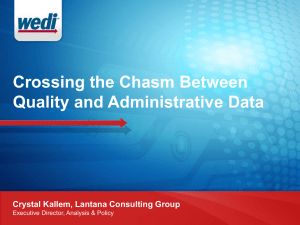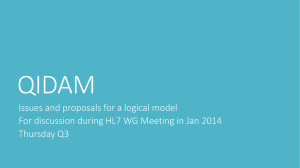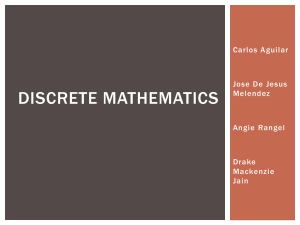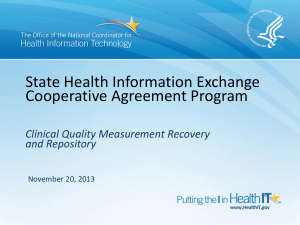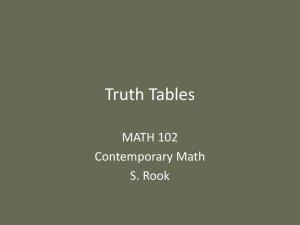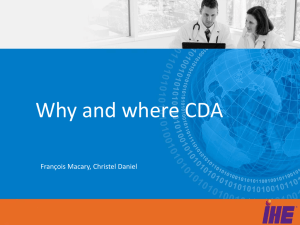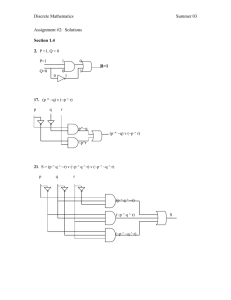Minutes_of_NegationIndExtension_Discussion_20150713
advertisement
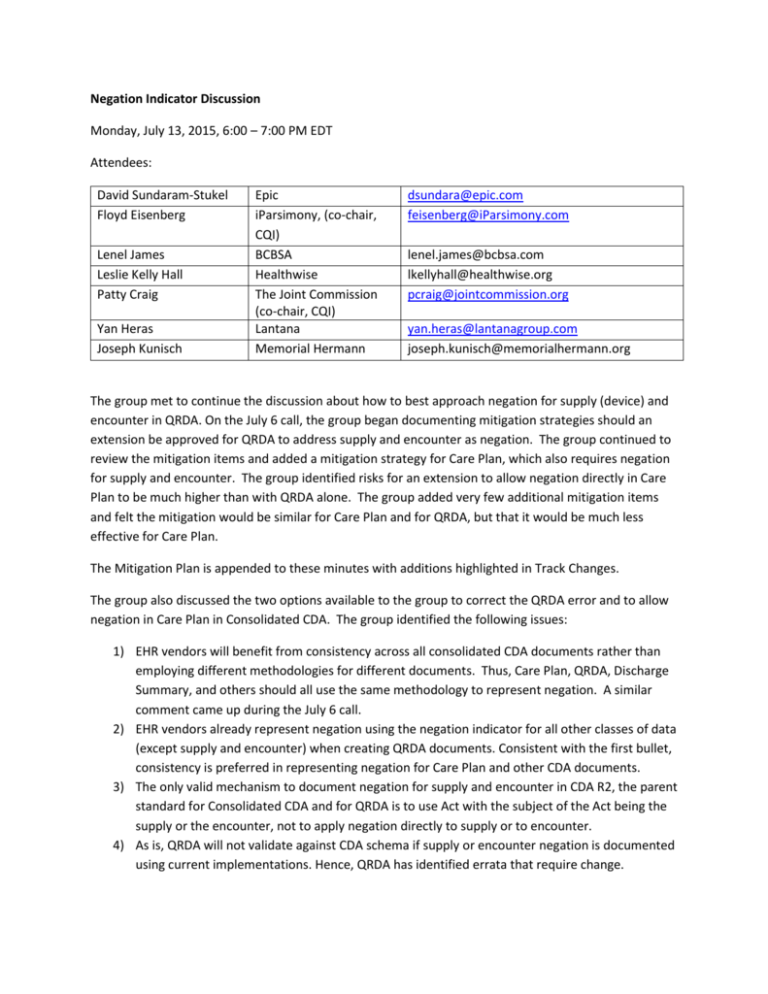
Negation Indicator Discussion Monday, July 13, 2015, 6:00 – 7:00 PM EDT Attendees: David Sundaram-Stukel Floyd Eisenberg Lenel James Leslie Kelly Hall Patty Craig Yan Heras Joseph Kunisch Epic iParsimony, (co-chair, CQI) BCBSA Healthwise The Joint Commission (co-chair, CQI) Lantana Memorial Hermann dsundara@epic.com feisenberg@iParsimony.com lenel.james@bcbsa.com lkellyhall@healthwise.org pcraig@jointcommission.org yan.heras@lantanagroup.com joseph.kunisch@memorialhermann.org The group met to continue the discussion about how to best approach negation for supply (device) and encounter in QRDA. On the July 6 call, the group began documenting mitigation strategies should an extension be approved for QRDA to address supply and encounter as negation. The group continued to review the mitigation items and added a mitigation strategy for Care Plan, which also requires negation for supply and encounter. The group identified risks for an extension to allow negation directly in Care Plan to be much higher than with QRDA alone. The group added very few additional mitigation items and felt the mitigation would be similar for Care Plan and for QRDA, but that it would be much less effective for Care Plan. The Mitigation Plan is appended to these minutes with additions highlighted in Track Changes. The group also discussed the two options available to the group to correct the QRDA error and to allow negation in Care Plan in Consolidated CDA. The group identified the following issues: 1) EHR vendors will benefit from consistency across all consolidated CDA documents rather than employing different methodologies for different documents. Thus, Care Plan, QRDA, Discharge Summary, and others should all use the same methodology to represent negation. A similar comment came up during the July 6 call. 2) EHR vendors already represent negation using the negation indicator for all other classes of data (except supply and encounter) when creating QRDA documents. Consistent with the first bullet, consistency is preferred in representing negation for Care Plan and other CDA documents. 3) The only valid mechanism to document negation for supply and encounter in CDA R2, the parent standard for Consolidated CDA and for QRDA is to use Act with the subject of the Act being the supply or the encounter, not to apply negation directly to supply or to encounter. 4) As is, QRDA will not validate against CDA schema if supply or encounter negation is documented using current implementations. Hence, QRDA has identified errata that require change. 5) Using Act only for supply and encounter is still feasible since no vendors have implemented negation for these classes of data. 6) Using extension with mitigation introduces patient safety risks, especially for Care Plan but also for QRDA. 7) The path forward if extension is to be applied to CDA R2 includes: a. Review with CTO to assure the mitigation plan is sufficient and acceptable b. Obtain approval by Structured Documents WG to allow the extension with the mitigation plan (and carry out the mitigation plan) – and publish c. Once (b) has occurred, gain approval from CQI WG to update QRDA, or at least apply errata which includes updating or creating templates to apply new namespaces and carry out the mitigation plan – and publish 8) The path forward if Act with negation is to be used includes: a. Modeling new templates for Care Plan and for QRDA to address Act (supply) negation and Act (encounter) negation b. Obtain approval by CQI WG to update QRDA and publish c. Add templates to Care Plan d. No changes need to be made to CDA-R2 or Consolidated CDA since Act with negation is allowed e. Recommendation: The group attending today’s call voiced preference for the Act negation solution only for supply and encounter across QRDA and Care Plan for the following reasons: a. The use of extension might be applied to QRDA but is highly unlikely to work for Care Plan. Therefore, Care Plan and QRDA would handle supply and encounter negation differently and Care Plan would use Act (supply) negation and Act (encounter) negation but handle negation similar to QRDA for all other classes of data. The solution provides multiple levels of inconsistency. b. The use of Act would create inconsistency in that other classes of data would continue to use negation directly and only supply and encounter would use Act. However, the group believes this is less of a concern than the risks of negation. c. Regardless of the solution eventually taken, QRDA must be updated or at least errata published. Next Steps: a. Review with the rest of the subgroup and obtain further feedback from implementers (Yan Heras) and EHR vendors (Lenel James). b. Hopefully, come to a conclusion and recommendation for the SD WG and CQI WG on next Monday’s subgroup call (July 20). The next call will be on Monday, July 20 at 6:00 PM EDT: 770-657-9270 passcode 310940# GotoMeeting: SD - NegationInd Discussion (6-7 ET Monday) https://global.gotomeeting.com/join/971938333 Negation Indicator Extension Risk Analysis Risk: QRDA Specific A Provider organization submits a QRDA CDA using the QRDA specific negationInd extension to a receiver and the receiver ignores the extension. The provider has met the related criteria, but the receiver misinterprets the QRDA submission because it ignored the negationInd. The provider receives reduced reimbursement due to the failure. Risk Type: Financial Risk Likelihood: low Risk Severity: low (current), may become higher at a later date Mitigation Plan: Payers and Providers both need implement the extension, probably involves a roll out plan for the industry Education (samples, training, HL7 Help desk article’s, HL7 Help Desk FAQ, Highlight in CDA training materials and tutorial materials.) Release a QRDA DSTU Update with updated templates using extension. Issue errata against the previous version with the correction. Certification testing should quickly adopt the new release of QRDA DSTU Update including the extension. Need to have extension specific test cases. Updated technical artifacts such as Schema and Schematron using the extension, making them publicly available. Communicate and/or coordinate with other organizations such as WEDI and other SDO’s Risk: Inappropriate Adoption of Extension outside of QRDA A provider organization using a vendor's advanced EHR application automatically harvests any clinical related quality data elements and incorporates them into the Clinical EHR. This data is automatically loaded into Clinical CDA’s sent to other providers using CDA structures related to the QRDA templates. In this case, the provider is collecting clinical data that requires use of negationInd on encounters or supplies. Clinical CDA’s are created and transmitted to other providers using the QRDA negationInd extension. The negationInd extension is ignored by a clinical receiver and a patient safety issue occurs. Risk Type: Patient Safety (which may lead to Financial risk also) Risk Likelihood: medium Risk Severity: high Mitigation Plan: Add a constraint in C-CDA to block use of the QRDA negationInd extension and do a C-CDA DSTU Update Education (samples, training, HL7 Help desk article’s, HL7 Help Desk FAQ, Highlight in CDA training materials and tutorial materials.) Issue errata against the previous version with the correction. Certification testing should quickly adopt the new release of C-CDA DSTU Update including the verifying the absence of the extension except in QRDA. Need to have extension specific test cases. Updated technical artifacts such as Schema and Schematron forbidding the extension for anything except QRDA, making them publicly available. Communicate and/or coordinate with other organizations such as EHR Vendors Association, IHE, CMS and The Joint Commission as a receiver etc. Use an extension namespace that clearly indicates it should not be used outside of QRDA. Assure CMS and The Joint Commission has an error identification process that is unambiguous for responding to senders when CMS receives messages with errors. Risk: Inappropriate Adoption of Extension outside of a Care Plan A provider organization using a vendor’s advanced EHR application automatically harvests documented clinical related data elements about interventions that did not occur with a reason and incorporates them into the EHR’s clinical decision support engine. This data is also automatically loaded into Clinical CDA’s sent to other providers using CDA structures related to the care plan templates. In this case, the provider is collecting clinical data that requires use of negationInd on encounters or supplies. Clinical CDA’s are created and transmitted to other providers and/or used in clinical decision support using the care plan negationInd extension. The clinical receiver ignores the negationInd extension and hence the intervention that was not performed is identified as if it had been performed and a patient safety issue occurs. Risk Type: Patient Safety (which may lead to Financial risk also) Risk Likelihood: High Risk Severity: Very High Mitigation: Mitigation Plan: Assure the namespace used is the same for QRDA and Care Plan, e.g., “do not use except in QRDA / Care Plan”. Identify specific examples of patient care risk from inappropriate use of a Care Plan workaround. Add a constraint in C-CDA to block use of the Care Plan negationInd extension and do a C-CDA DSTU Update. Education (samples, training, HL7 Help desk article’s, HL7 Help Desk FAQ, Highlight in CDA training materials and tutorial materials.) Certification testing should quickly adopt the new release of C-CDA DSTU Update including the verifying the absence of the extension except in QRDA. Need to have extension specific test cases. Updated technical artifacts such as Schema and Schematron forbidding the extension for anything except Care Plan, making them publicly available. Communicate and/or coordinate with other organizations such as EHR Vendors Association, IHE, CMS and The Joint Commission as a receiver etc. Use an extension namespace that clearly indicates it should not be used outside of Care Plan. Assure CMS and The Joint Commission has an error identification process that is unambiguous for responding to senders when CMS receives messages with errors.
